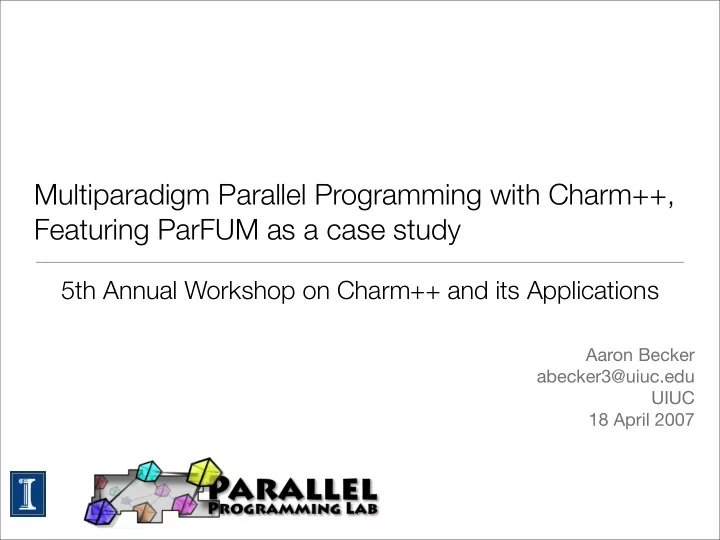

Multiparadigm Parallel Programming with Charm++, Featuring ParFUM as a case study 5th Annual Workshop on Charm++ and its Applications Aaron Becker abecker3@uiuc.edu UIUC 18 April 2007
What is Multiparadigm Programming?
There are lots of ways to write a parallel program Global Arrays BSP X10 OpenMP High Performance Fortran Fortress MPI Parallel Matlab Charm++ Multiphase Shared Arrays Unified Parallel C Chapel
Why are there so many languages?
Why are there so many languages? Each is good at something different Automatic parallelizing of loops Fine-grained parallelism Unpredictable communication patterns
So, what is a multiparadigm program? A program composed of modules, where each module could be written in a different language
Why would I want a Multiparadigm Program?
Suppose you have a complex program to parallelize
Suppose you have a complex program to parallelize Each phase of the program may have different patterns of communication How can you decide which language to use?
Suppose you have a complex program to parallelize A common approach: shoehorn everything into MPI A better approach: choose the right language for each module
Suppose you have an existing MPI program You want to add a new module, but it will be tough to write in MPI
Suppose you have an existing MPI program You want to add a new module, but it will be tough to write in MPI A common approach: write it in MPI anyway A better approach: choose a better suited language
Why aren’t multiparadigm programs more common? Multiparadigm programs are hard to write: You need a way to stick these modules together It’s relatively simple if you only have one language in use at once: MPI/OpenMP hybrid codes run just one language at a time For tightly integrated codes with multiple concurrent modules, you need a runtime system to manage them all
Where does Charm++ fit in? The Charm++ runtime system (RTS) handles most of the difficulties of multiparadigm programming Modules using different languages are co-scheduled and can integrate tightly with one another The RTS supports several languages We are interested in adding more
ParFUM: a Multiparadigm Charm++ Program
What is ParFUM? ParFUM: a Parallel Framework for Unstructured Meshing Meant to simplify the development of parallel unstructured mesh codes Handles partitioning, synchronization, adaptivity, and other difficult parallel tasks
ParFUM is multiparadigm ParFUM consists of many modules, written in a variety of languages. I will briefly present three examples: Charm++ for asynchronous adaptivity Adaptive MPI for the user’s driver code and glue code to connect modules Multiphase shared arrays (MSA) for data distribution
Charm++ in ParFUM
Asynchronous Incremental Adaptivity Local refinement or coarsening of the mesh, without any global barriers. Edge bisection on a processor boundary
What is Charm++? I hope you attended the fine tutorial by Pritish Jetley and Lukasz Wesolowski In a nutshell, parallel objects which communicate via asynchronous method invocations
Why is Charm++ good for incremental adaptivity? Incremental adaptivity leads to unpredictable communication patterns. 1 2 Suppose a boundary element of partition 1 requests refinement How will partition 2 know to expect communication from 1? In MPI, this is very hard. In Charm++, it is natural.
Adaptive MPI in ParFUM
What is Adaptive MPI? For our purposes, it’s just an implementation of MPI on top of the Charm++ RTS For more information, see Celso Medes’s tutorial on Friday at 3:10, How to Write Applications using Adaptive MPI
Why is Adaptive MPI important in ParFUM? User provided driver code Users are most likely to know MPI, and we want to allow them to use it for their code Glue code between modules Flow of control is more obvious in MPI code than in Charm++ code, which makes it good for glue code
Why is Adaptive MPI important in ParFUM? User provided driver code Popularity Legacy Glue code between modules Simple flow of control
Multiphase Shared Arrays (MSA) in ParFUM
A data distribution problem After initial partitioning, we need to determine which boundary elements must be exchanged.
A data distribution problem After initial partitioning, we need to determine which boundary elements must be exchanged. What we would like: an easily accessible global table to look up shared edges
What is MSA? Idea: shared arrays, where only one type of access is allowed at a time Access type is controlled by the array’s phase Phases include: read-only write-by-one accumulate
Read-only mode
Write-by-one mode note: one thread could write to many elements
Accumulate mode note: accumulation operator must be associative and commutative
Distributed MSA Hash Table Partitioned Mesh
Each shared edge is hashed
Entries are added to the table in accumulate mode
Now elements which collide in the table probably share an edge
Why is MSA good for this application? Shared access to a global table is convenient when trying to determine which partitions you need to send to or receive from Filling and consulting the array fit neatly into MSA phases
Recommend
More recommend